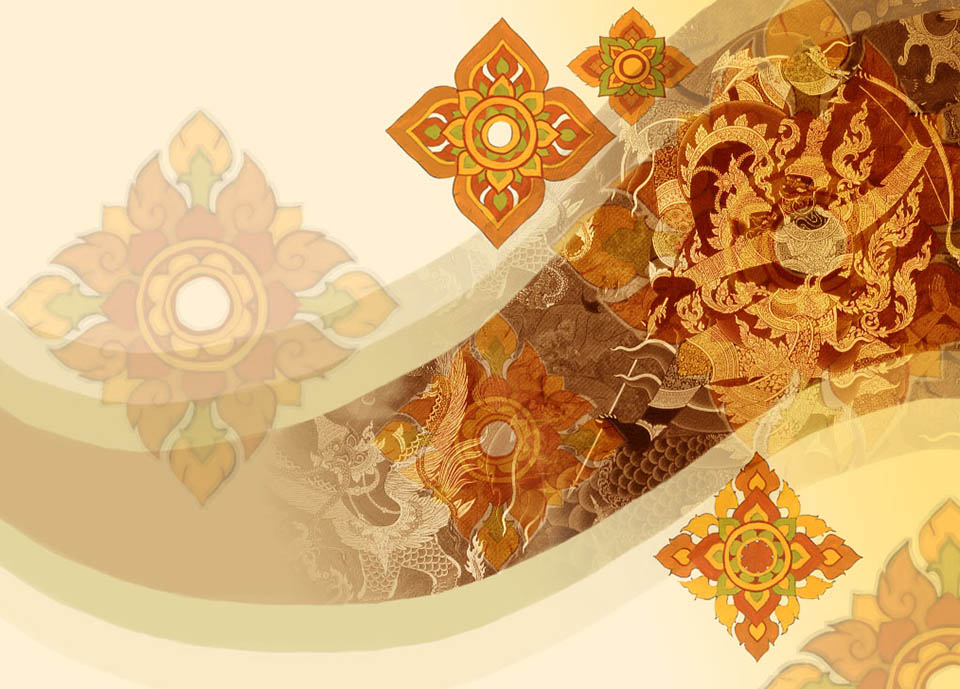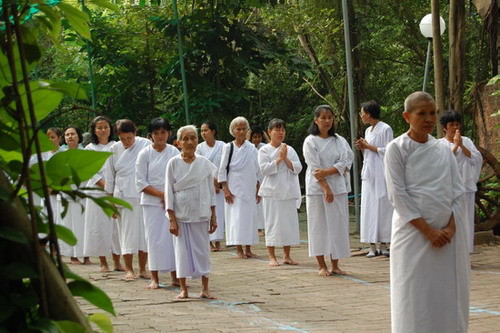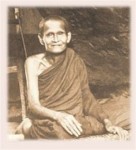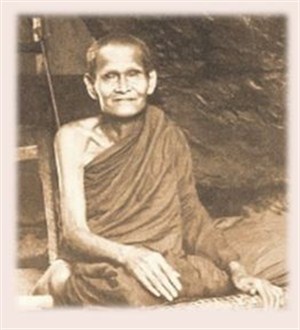Kammatthana
Kammatthana literally means “basis of work” or “place of work”. It describes the contemplation of certain meditation themes used by a meditating monk so the forces of defilement (kilesa), craving (tanha), and ignorance (avijja) may be uprooted from the mind. Although kammatthana can be found in many meditation-related subjects, the term is most often used to identify the forest tradition (the Kammatthana tradition) lineage founded by Ajarn Sao Kantasilo Mahathera and his student Ajarn Mun Bhuridatta Mahathera.
The origin of the name Forest tradition came from the theory that the Buddha himself gained awakening in a forest, gave his first sermon in a forest, and passed away in a forest. The qualities of mind he needed in order to survive physically and mentally in the wilds, were key to his discovery of the Dhamma. Therefore every practitioner should take the wilderness as the teacher, conform to the ways of nature – the samsara itself — and break through to truths transcending them entirely.

Ajarn Sao (1861-1941) originally belonged to the Dhammayut order in that he unusually had no scholarly interests but was devoted to the practice of meditation. He trained Ajarn Mun in strict discipline and canonical meditation practices, set in the context of the dangers and solitude of the wilderness.

Ajarn Mun (1870-1949) was the son of rice farmers in the northeastern province of Ubon Ratchathani province, northeastern Thailand. Ordained as a Buddhist monk in 1892, he felt that Customary Buddhism had little to offer and so he joined the Dhammayut order, taking a student of Prince Mongkut as his preceptor. Unlike many Dhammayut monks, he wasn’t interested in the scholarly environment of his preceptor’s temple and went to live with Ajarn Sao. After wandering for several years with Ajarn Sao, Ajarn Mun set off on his own in search of the truth and spent the remainder of his life wandering through central Thailand, Burma, and Laos, dwelling for the most part in the forest, engaged in the practice of meditation. Eventually, when Ajarn Mun had reached the point where he believed the noble attainments was reachable, he returned to the northeast to inform Ajarn Sao and then to continue wandering. Gradually he attracted followers that were impressed by his demeanor and teachings. They believed that he embodied the Dhamma and Vinaya in everything he did and said. Instead of teaching a single meditation technique, Ajarn Mun taught them full panoply of skills and then sent them into the wilds. In 1928, a Dhammayut authority ordered Ajarn Mun‘s followers to establish monasteries and help propagate the government’s program for the purpose of domestication against these forest wanderers. Ajarn Mun and a handful of his students left for the north, where they were still free to roam. In the early 1930’s, Ajarn Mun was appointed the abbot of an important monastery in the city of Chieng Mai, but fled the place before dawn of the following day. He returned to settle in the northeast only in the very last years of his life. He maintained many of his dhutanga practices up to his death in 1949.
Ajarn Lee Dhammadharo (1907-1961) was one of the foremost teachers in the Thai forest ascetic tradition of meditation founded at the turn of the century by his teacher, Ajarn Mun. His life was short but eventful. Known for his skill as a teacher and his mastery of supranatural powers, he was the first to bring the ascetic tradition out of the forests of the Mekhong basin and into the mainstream of Thai society in central Thailand.
The forest meditation tradition subsequently spread throughout Thailand and to several countries abroad.
Basic Teachings
This sect follows the Vinaya (monastic discipline) faithfully. They believe the rules of the Vinaya, instead of simply being external customs, played an important role in physical and mental survival. The practitioners observe many of what are known as the thirteen classic dhutanga (ascetic) practices, such as living off almsfood, wearing robes made of cast-off rags, dwelling in the forest, eating only one meal a day. The teaching focuses on the customs of the noble ones: the practices that had enabled the Buddha and his disciples to achieve awakening in the first place. And they believe the true Dhamma cannot be found in old customs or texts but in the well-trained heart and mind.
This attitude toward the Dhamma parallels what ancient cultures called “warrior knowledge” — the knowledge that comes from developing skills in difficult situations — as opposed to the “scribe knowledge” that people sitting in relative security and ease can write down in words. A text is pointers for training and authoritative only if its teachings are borne out in practice. Thus the ultimate authority in judging a teaching is not whether the teaching can be found in a text but the results of relentless honesty in putting the Dhamma to the test and carefully monitoring. So that one learned gradually by trial and error to the point of an actual noble attainment. Instead of simply imparting verbal knowledge, a practitioner will be put into situations where they would have to develop the qualities of mind and character needed in surviving the battle with their own defilements. These included resilience, resolve, and alertness; self-honesty and circumspection; steadfastness in the face of loneliness; courage and ingenuity in the face of external dangers; compassion and respect for the other inhabitants of the forest.
It will appear of its own accord to the person who practices; because virtue, concentration, and discernment all exist in our very own body, speech, and mind. These things are said to be;
Akaliko: Ever-present.
Opanayiko: Bring the mind inward to investigate body, speech, and mind when a practitioner contemplate what already exists within him/her.
Aloko: Blatantly clear both by day and by night;
Paccattam: Knew clearly for themselves after bringing their minds inward to contemplate what was already there.
Keeping awareness with the breath is directed thought. Knowing the characteristics of the breath is evaluation. Spreading the breath so that it permeates and fills the entire body is rapture. The sense of serenity and well-being in body and mind is pleasure. When the mind is freed from the Hindrances so that it’s one with the breath, that’s singleness of preoccupation. All of these factors of jhana turn mindfulness into a factor of Awakening.
Breath Training
The most important meditation technique is this sect is to focus on the in-and-out breath and to keep mindfulness in charge, together with the meditation word, buddho (“Buddha”, used as the meditation word), in and out with the breath. The meditation word is like bait; it should be dropped once the mind is in place. Being mindful and alert to the in-and-out breath is the actual meditation. When the body is still, the practitioner gain knowledge from the body. When the mind is still, the practitioner gain knowledge from the mind. When the breath is still, the practitioner gain knowledge from the breath.
There are five levels to the breath:
- The breath that we breathe in and out.
- The breath that goes past the lungs and connects with the various properties of the body, giving rise to a sense of comfort or discomfort.
- The breath that stays in place throughout the body. It doesn’t flow here or there. The breath sensations that used to flow up and down the body stop flowing. The sensations that used to run to the front or the back stop running. Everything stops and is still.
- The breath that gives rise to a sense of coolness and light.
- The really refined breath, so refined that it’s like atoms. It can penetrate the entire world. Its power is very fast and strong.
There are two kinds of breath evaluation: the first is to evaluate the in-and-out breath. The second is to evaluate the inner breath sensations in the body until the practitioner can spread them out through all the properties of the body to the point where the practitioner forget all distractions. If both the body and mind are full, there’s a sense of rapture and ease that results from the directed thought and evaluation. This is Right Action in the mind.
Breath Training and Eight Noble Paths
The in-breath stress is the stress of arising and the out-breath stress is the stress of passing away. When a practitioner concentration has strength through the breath training, the ability to discern stress, its cause, its disbanding, and the path to its disbanding will rise within the breath. When all of these aspects of the Noble Path — virtue, concentration, and discernment — are brought together fully mature within the heart, the practitioner gain insight into all aspects of the breath. This includes the knowledge of the relation between the breathing method and good/bad mental states. The breath that fashion the body, the factors that fashion speech, the factors that fashion the mind, whether good or bad, letting them be as they truly are, in line with their own inherent nature. As the practice itself, it can be concluded in the Buddha’s Noble Eightfold Path:
Right View – Knowing when the breath is coming in, knowing when it’s going out, knowing its characteristics clearly — i.e., keeping the views in line with the truth of the breath.
Right Consideration – Knowing which ways of breathing are uncomfortable, knowing how to vary the breath.
Right Speech – The mental factors that think about and properly evaluate all aspects of the breath.
Right Action – Knowing various ways of improving the breath; breathing, for example, in long and out long, in short and out short, in short and out long, in long and out short, until the breath becomes most comfortable.
Right Livelihood – Knowing how to use the breath to purify the blood, how to let this purified blood nourish the heart muscles, how to adjust the breath so that it eases the body and soothes the mind, how to breathe to feel full and refreshed in body and mind.
Right Effort – Trying to adjust the breath so that it comforts the body and mind, and to keep trying as long as possible.
Right Mindfulness – Being mindful of the in-and-out breath at all times, knowing the various aspects of the breath — the up-flowing breath, the down-flowing breath, the breath in the stomach, the breath in the intestines, the breath flowing along the muscles and out to every pore — keeping track of these things with every in-and-out breath.
Right Concentration – A mind intent only on matters of the breath, not pulling any other objects in to interfere, until the breath is refined, giving rise to fixed absorption and then liberating insight.
Meditation paths
With respect to the meditation on physical events that qualifies as the great frame of reference (mahasatipatthana), when the practitioner’s mind has fully developed the four paths to success (listed as bellow), complete with mindfulness and alertness, the results in terms of the body are the stilling of pain. In terms of the mind, they can lead all the way to the transcendent: the stages of stream-entry, once-returning, non-returning, and arahantship. The four paths to success are:
Chanda (desire): Have a friendly interest in the breath, keeping track of it to see when breath is in and what breathe in with it.
Viriya (persistence): Be diligent in all affairs related to the breath and be in charge of the breath.
Citta (attention): Focus intently on the breath. Be observant of how the external breath comes in and connects with the internal breath in the upper, middle, and lower parts of the body; in the chest — the lungs, the heart, the ribs, the backbone; in the abdomen — stomach, liver, kidneys, intestines; the breath that goes out the ends of the fingers and toes and out every pore.
Vimansa (discrimination): Contemplate and evaluate the breath that comes in to nourish the body to see whether it fills the body, to see whether it feels easy and natural, to see if there are many parts the body still have to adjust it. Notice the characteristics of how the external breath strikes the internal breath, to see if they connect everywhere or not, to see how the effects of the breath on the properties of earth, water, and fire arise, remain, and pass away.
In terms of concentration, there are three levels in the practice:
Momentary concentration- the mind gathers and settles down to a firm stance (a underlying level) and rests there for a moment before withdrawing.
Threshold concentration – the mind gathers and settles down to its underlying level and stays there before withdrawing to be aware of a nimitta (mental sign, image, or vision). Or without retreating, the practitioner meditates until an uggaha nimitta (arising image) appears, contemplates that image until the mind lets go of it and reverts to its underlying level and stays there for a fair while before withdrawing again.
Fixed penetration – the mind settles down to a firm stance on its underlying level and stops there in singleness endowed with the five factors of jhana. Keep on contemplating that image until the mind reverts to a firm stance on its underlying level, reaching the singleness of the first level of jhana. When the mind withdraws, keep contemplating that image over and over again until the practitioner can take it apart as a patibhaga nimitta (counterpart image).
Note: jhana (Skt. dhyana): Mental absorption. A state of strong concentration focused on a single physical sensation (resulting in rupa jhana) or mental notion (resulting in arupa jhana). Develompent of jhana arises from the temporary suspension of the five hindrances through the development of five mental factors: vitakka (directed thought), vicara (evaluation), piti (rapture), sukha (pleasure), and ekaggatarammana (singleness of preoccupation).
Seven factors of Awakening
Forest tradition practitioners believe the hindrances are the breath impregnated with ignorance and darkness, thus the untended and undirected breath is full of darkness. This state cuts and closes off our path to enlightenment. Only if these hindrances are removed, the mind will be radiant and bright. And seeing the Dhamma can be clear in both cause and effect. Concentration is the most effective way to divest our hearts of sights, sounds, smells, tastes, etc. And it is composed of seven basic qualities as the factors of Awakening. Appreciating all seven of these qualities and developing them in full measure within the heart will result a single point awakening in a single moment.
1. Mindfulness (sati-sambojjhanga): The mind is centered firmly on the breath, aware of the body, feelings, mind, and mental qualities.
2. Analysis of present qualities (dhamma-vicaya-sambojjhanga): Let the breath spread throughout the body to care for its various parts, making an enlarged frame of reference. To adjust, improve, choose, and use our breaths so that they give us comfort.
3. Persistence (viriya-sambojjhanga): Stick with the state as the practitioner keeps warding the Hindrances from the heart. Don’t fasten on or become involved with distracting perceptions.
4. Rapture (piti-sambojjhanga): When the mind is quiet, the breath is full and refreshing. The practitioner is free from the hindrances and from every sort of restlessness; it gives rise to a feeling of brightness, fullness, and satisfaction. This is the breath of cognitive skill (vijja), meaning the breath lies under the direction of mindfulness.
5. Serenity (passaddhi-sambojjhanga): The breath is solid throughout the body. The elements are at peace, and so is the mind. Feelings are still experienced as they are felt, but at this point they don’t give rise to craving, attachment, states of being, or birth. Awareness is simply aware.
6. Concentration (samadhi-sambojjhanga): The breath is firm, steady, and unwavering. The mind takes a firm stance in a single preoccupation so the knowledge arises. The practitioner will perceive kamma and its results, both in ourselves and other people in this state.
7. Equanimity (upekkha-sambojjhanga): When body, feelings, mind, and mental qualities are fully snug with one another in these two types of breath — the mind stays with these aspects of the breath — it goes to be still with a spacious sense of relaxation, not fastening onto many sign, preoccupation, or anything at all.
When mindfulness saturates the body the way flame saturates every thread in the mantle of a Coleman lantern, the elements throughout the body work together, both the body and mind become buoyant. The sense of the body will immediately become thoroughly bright, helping to develop both body and mind. The practitioner can now sit or stand for long periods of time without getting tired, to walk for great distances without getting fatigued, to go for unusually long periods of time on just a little food without getting hungry, or to go without food and sleep altogether for several days running without losing energy.
Samatha and Vipassana
Tranquillity meditation (samatha) is a mind snug in a single preoccupation. It doesn’t establish contact with anything else; it keeps itself cleansed of outside preoccupations. Insight meditation (vipassana) is when the mind lets go of all preoccupations in a state of all-around mindfulness and alertness. When tranquillity imbued with insight arises in the mind, five faculties arise and become five kinds of strength:
1. Saddhindriya (Saddha-balam): conviction; the practitioner gain conviction in the results from his/her efforts.
2. Viriyindriya (Viriya-balam): persistence arises and becomes resilient without flagging or getting discouraged.
3. Satindriya (Sati-balam): mindfulness be robust and vigorous. The awareness becomes entirely radiant in every posture: sitting, standing, walking, and lying down. This all-around awareness is what is meant by the great frame of reference.
4. Samadhindriya (Samadhi-balam): concentration becomes firmly established.
5. Panyaindriya (Panya-balam): discernment of all things right and wrong. Discernment can make the mind attain stream-entry, once-returning, non-returning, or even arahantship.
When these five strengths appear in the heart, the heart will be fully mature. The practitioner’s conviction, persistence, mindfulness, concentration, and discernment will all be mature and pre-eminent in their own spheres. The mind will have the power to demolish all defilement in the heart.
Further information on the following links;
Kammathana 40 Vipassana techniques of Mindfulness
Download and listen to “Letting Go”, a free Mp3 teaching by Thanissaro Bhikkhu







![Reblog this post [with Zemanta]](http://img.zemanta.com/reblog_b.png?x-id=8ba6410d-d768-48f0-be38-443ffb9e947d)